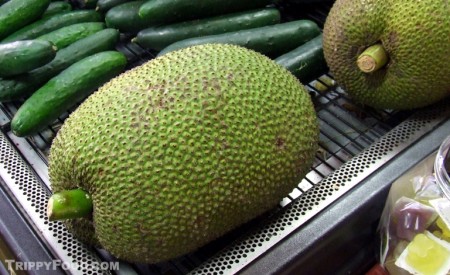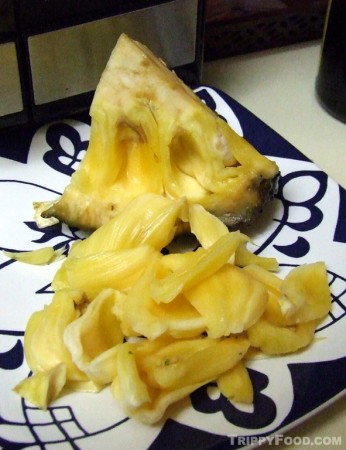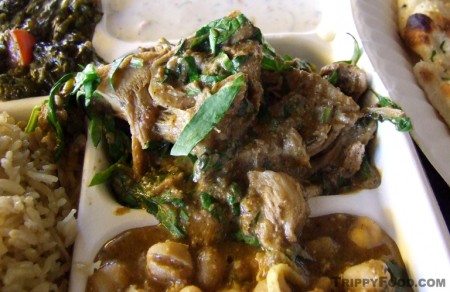Jackfruit
South and East Asia
While durian is referred to as the “king of fruit”, it is generally dwarfed in size by the jackfruit, the largest tree-borne fruit in the world (attaining a weight of up to 80 pounds). The jackfruit is similar in appearance to the durian but it is unrelated – the jackfruit is covered with small, dull bumps, while the durian looks like something that might grow in Gene Simmons’ yard; although a slight unpleasant smell may be present on the outside of the ripe jackfruit, it doesn’t adopt its spiky neighbor’s nasty habit of smelling like dirty gym socks stuffed with old onions. Originally found in South and East Asia, the fruit has been dispersed to other tropical areas (primarily by Portuguese traders in the East Indies). The Portuguese were the first to describe the fruit to the western world, but there is enough evidence to substantiate that it has been harvested and eaten for millennia. Jackfruit is found in Indian, Sri Lankan, Indonesian, and Southeast Asian cuisine and is sold in markets worldwide fresh, canned in syrup and as fried chips; it is also used for shakes and smoothies and can be found in ice cream.
Other parts of the tree besides the fruit are used for a variety of purposes – the sturdy wood is used to make furniture, the milky-white resin found in the stems is used to make adhesives, and even the leaves are used in cooking. In its unripened (young) form, the jackfruit is only edible when cooked, but the ripened, older fruit can be eaten raw (although overindulgence of the fruit has been said to bring on the Hershey squirts). The woody outer parts are difficult to eat, and the large seeds can be eaten but need to be boiled or roasted first; the fresh, fruity part is the yellow pouch-like segments scattered within. The fleshy pods have high water content and have a slight smooth, sweet and citrus taste like the merging of a pineapple and a banana.
In Southeast India, the young fruit is cooked in curry, and since even the pulpy section is used the jackfruit takes on a meat-like characteristic. The texture is similar to white albacore tuna, with the taste somewhere between the poultry and pork spectrums. In Los Angeles, Samosa House is a vegetarian Indian restaurant that has jackfruit curry on the menu almost daily; the flavor is indescribable but I’ve become addicted to it like a crack whore, sometimes having it for lunch twice a week. Samosa House doesn’t have table service – to order, you walk through the tiny grocery featuring fresh foods such as okra, various types of eggplant, Indian bitter melon and even fresh jackfruit to the counter where the offerings of the day are presented in glassed-in steam trays. Hand-written signs advertise what is on the menu, but most people go for the combination plate, which includes three vegetarian dishes, a yogurt sauce, basmati rice and nan. I always get the jackfruit, but gravitate towards the saag (spinach) and bitter melon curry as well when it is available. There’s no fancy tablecloths, silverware or cloth napkins here, but it’s easy to dispense with the formality with the collection of Indian heaven gently ladled into the Styrofoam compartments on the tray. After eating, take a stroll down the aisles of the grocery, featuring all the spices and dried, fresh, canned and frozen food items you’d need to make a splendid Indian feast at home. There’s also a wide selection of teas and British items, a reminder of India’s old colonial days (you can even stock up on your Marmite here).
Fresh jackfruit is somewhat formidable-looking, but its flavor and versatility makes it a fruit worth checking out. In fact, I may have to put in a word to the guy in the suit and the giant ping pong ball head to add it to their menu – they wouldn’t even have to change the name.
Samosa House
11510 West Washington Blvd.
Los Angeles, CA 90066
GPS coordinates: 34°0’3.52″N 118°24’58.38″W





